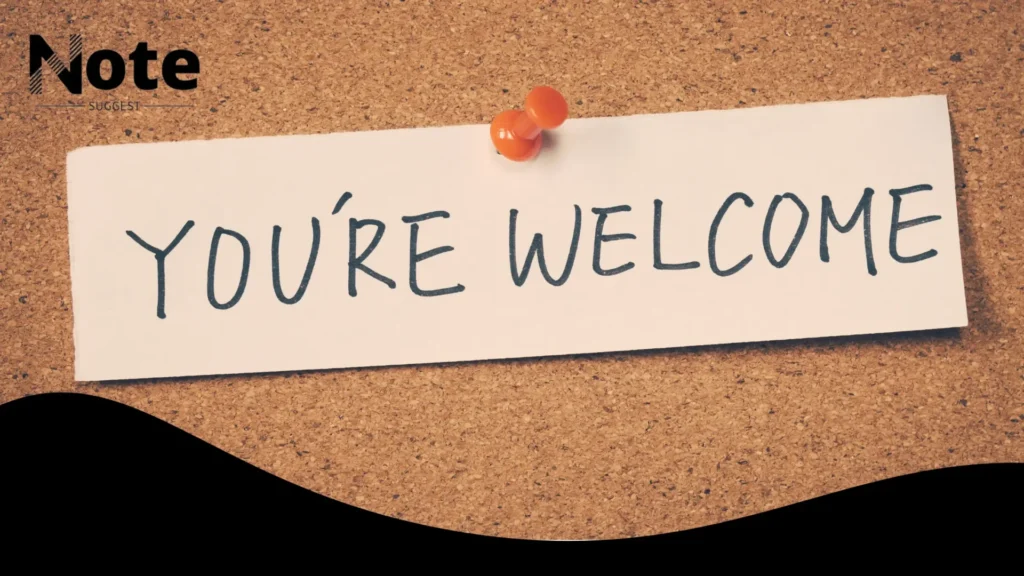
When someone says “thank you,” the usual reply is “You’re welcome.” But there are many other ways to respond, depending on the situation. Using different phrases can make your conversations sound more natural and friendly.
In this article, you’ll find 15 other ways to say “You’re welcome,” along with examples of when to use them. Whether you’re in a formal setting, chatting with friends, or just keeping things casual, these responses will help you sound more confident.
Let’s explore these alternatives and see how they fit into everyday conversations!
Contents
- 1 Is It Professional To Say “You’re Welcome”
- 2 15 Other Ways to Say “You’re Welcome”
- 2.1 1. No problem.
- 2.2 2. Happy to help.
- 2.3 3. Don’t mention it.
- 2.4 4. Anytime.
- 2.5 5. My pleasure.
- 2.6 6. Glad I could assist.
- 2.7 7. That’s alright.
- 2.8 8. It was nothing.
- 2.9 9. Sure thing.
- 2.10 10. Of course.
- 2.11 11. Happy to be of service.
- 2.12 12. No worries.
- 2.13 13. Always here to help.
- 2.14 14. You got it.
- 2.15 15. Anytime you need.
- 2.16 Conclusion
- 2.17 FAQS
Is It Professional To Say “You’re Welcome”
Saying “You’re welcome” is generally considered professional and polite in most workplaces. It shows good manners and acknowledges the other person’s gratitude. However, in some formal settings, alternatives like “My pleasure” or “Glad to help” might sound even more polished.
The best response depends on the tone of the conversation and the workplace culture. If the environment is formal, a more professional phrase might be better. But in casual or friendly workplaces, a simple “You’re welcome” is perfectly fine.
15 Other Ways to Say “You’re Welcome”
Discover 15 different ways to say “You’re welcome” with examples for various situations.
- No problem.
- Happy to help.
- Don’t mention it.
- Anytime.
- My pleasure.
- Glad I could assist.
- That’s alright.
- It was nothing.
- Sure thing.
- Of course.
- Happy to be of service.
- No worries.
- Always here to help.
- You got it.
- Anytime you need.
>> Related Guide: 15 Other Ways to Say “How Dare You” (With Scenarios)
1. No problem.

This phrase is a casual way to acknowledge gratitude without making a big deal about it. It reassures the other person that helping them wasn’t an inconvenience. It’s commonly used in everyday conversations, especially among friends, colleagues, or even in customer service settings.
Scenario: Emma forgot her notebook at home, and her friend Jake lent her his notes. When Emma said, “Thank you so much, Jake,” he simply smiled and replied, “No problem.”
| Phrase | Usage Context | Formal/Informal | Alternative Phrases |
| No problem. | Everyday interactions, casual conversations. | Informal | Not a problem, No worries, Anytime. |
2. Happy to help.
This phrase conveys enthusiasm in assisting someone. It reassures the person that you genuinely enjoyed providing help. It is commonly used in workplaces and customer service interactions.
Scenario: Sarah helped her colleague, Mike, fix an issue with his spreadsheet. Mike thanked her, and she replied, “Happy to help!”
| Phrase | Usage Context | Formal/Informal | Alternative Phrases |
| Happy to help. | Workplace, customer service, casual conversations. | Both | My pleasure, Always here to help. |
3. Don’t mention it.
This phrase suggests that the favor or help given was so small that it doesn’t even need to be acknowledged. It’s a humble way to respond to gratitude.
Scenario: Tom helped his elderly neighbor carry groceries to her doorstep. She thanked him, and he said, “Don’t mention it.”
| Phrase | Usage Context | Formal/Informal | Alternative Phrases |
| Don’t mention it. | Helping others in small acts of kindness. | Informal | It was nothing, No worries. |
>> Enjoy these helpful notes: Let Me Know
4. Anytime.
This phrase expresses a willingness to help again in the future. It suggests that the person can count on you whenever they need assistance.
Scenario: Lisa borrowed a pen from John during a meeting and thanked him afterward. John smiled and said, “Anytime.”
| Phrase | Usage Context | Formal/Informal | Alternative Phrases |
| Anytime. | Casual conversations, friendly interactions. | Informal | Always here to help, Sure thing. |
5. My pleasure.
A polite and formal way to express that helping someone was enjoyable. It’s often used in customer service or formal settings.
Scenario: A waiter refilled a customer’s drink. When the customer thanked him, he responded, “My pleasure.”
| Phrase | Usage Context | Formal/Informal | Alternative Phrases |
| My pleasure. | Customer service, formal conversations. | Formal | Happy to be of service, Glad to assist. |
6. Glad I could assist.
This phrase expresses a sense of fulfillment in helping someone. It’s often used in professional settings.
Scenario: A tech support agent resolved a customer’s computer issue. When the customer thanked him, he replied, “Glad I could assist.”
| Phrase | Usage Context | Formal/Informal | Alternative Phrases |
| Glad I could assist. | Professional, customer support. | Formal | Happy to help, Always here to assist. |
>> Explore these useful insights: Thinking of You
7. That’s alright.

This phrase reassures someone that they shouldn’t feel bad for needing help. It’s a comforting response.
Scenario: A coworker accidentally spilled coffee and apologized. Jane, who helped clean up, said, “That’s alright.”
| Phrase | Usage Context | Formal/Informal | Alternative Phrases |
| That’s alright. | Reassuring someone, casual conversations. | Informal | No worries, It’s okay. |
8. It was nothing.
A humble way to downplay the effort put into helping someone. It shows that the help wasn’t a burden.
Scenario: Ben helped his friend move furniture. When thanked, he said, “It was nothing.”
| Phrase | Usage Context | Formal/Informal | Alternative Phrases |
| It was nothing. | Friendly gestures, small favors. | Informal | Don’t mention it, No problem. |
9. Sure thing.
A casual and enthusiastic way to agree to help. It is commonly used among friends.
Scenario: Mia asked her friend to pick up a book for her, and he replied, “Sure thing!”
| Phrase | Usage Context | Formal/Informal | Alternative Phrases |
| Sure thing. | Friendly conversations. | Informal | Anytime, No problem. |
>> Check out these handy tips: Sorry for Your Loss
10. Of course.
A reassuring way to show that helping was natural and expected. It’s used in both casual and formal settings.
Scenario: A student asked a teacher for extra help. The teacher said, “Of course, I’d be happy to help.”
| Phrase | Usage Context | Formal/Informal | Alternative Phrases |
| Of course. | Casual, professional, customer service. | Both | No problem, Anytime. |
11. Happy to be of service.
A formal way of saying that helping was satisfying. It’s common in customer service and professional settings.
Scenario: A hotel concierge helped a guest with directions. The guest thanked him, and he replied, “Happy to be of service.”
| Phrase | Usage Context | Formal/Informal | Alternative Phrases |
| Happy to be of service. | Customer service, hospitality. | Formal | My pleasure, Glad to assist. |
12. No worries.
A relaxed way to tell someone that they don’t need to feel bad for asking for help.
Scenario: Chris accidentally stepped on Lisa’s foot and apologized. She replied, “No worries.”
| Phrase | Usage Context | Formal/Informal | Alternative Phrases |
| No worries. | Casual conversations, reassurances. | Informal | That’s alright, It’s okay. |
>> Discover more helpful guides: Proud of You
13. Always here to help.
Expresses an ongoing willingness to assist whenever needed.
Scenario: A manager helped an employee solve a problem. The employee thanked him, and he said, “Always here to help.”
| Phrase | Usage Context | Formal/Informal | Alternative Phrases |
| Always here to help. | Workplace, friendships. | Both | Anytime, You got it. |
14. You got it.
A confident and encouraging way to confirm help.
Scenario: A customer asked a barista for an extra napkin, and the barista replied, “You got it!”
| Phrase | Usage Context | Formal/Informal | Alternative Phrases |
| You got it. | Friendly interactions, customer service. | Informal | Sure thing, No problem. |
15. Anytime you need.

A warm way to show continued support.
Scenario: A mentor guided a student through a project. When thanked, he said, “Anytime you need.”
| Phrase | Usage Context | Formal/Informal | Alternative Phrases |
| Anytime you need. | Professional, personal support. | Both | Always here to help, No problem. |
>> Take a look at these valuable pointers: Happy Birthday in Advance
Conclusion
There are many ways to say “You’re welcome,” and choosing the right phrase depends on the situation and level of formality. From casual responses like “No problem” and “Sure thing” to more professional alternatives such as “My pleasure” and “Happy to assist,” each phrase helps create a natural and appropriate interaction. Understanding these variations can improve your communication skills, whether you’re in a workplace, social setting, or customer service role.
By using different responses, you can make your conversations more engaging and reflect the right tone for each situation. Whether you want to sound polite, enthusiastic, or reassuring, these alternatives offer flexibility in how you acknowledge gratitude. So, the next time someone thanks you, try switching up your response to match the moment!
FAQS
What can I say except you’re welcome audio?
The phrase comes from the song You’re Welcome by Dwayne “The Rock” Johnson in Moana. You can find the audio on platforms like YouTube, Spotify, or TikTok.
What to respond instead of you’re welcome?
You can say “No problem,” “My pleasure,” “Anytime,” or “Happy to help,” depending on the situation and level of formality.
What is the alternative of you’re welcome?
Alternatives include “Don’t mention it,” “Of course,” “Sure thing,” “No worries,” and “Glad I could help,” among others.
What do Americans say instead of you’re welcome?
In casual settings, Americans often say “No problem” or “No worries.” In formal situations, phrases like “My pleasure” or “Happy to assist” are more common.

